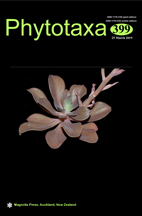Abstract
We herein describe two new species of Myrciaria (Myrtaceae) from the Brazilian Atlantic Forest, Myrciaria cambuca and M. una. The two species have long rusty trichomes on the branches and leaves, and were, for a long time, identified as Myrciaria ferruginea. Both are morphologically similar and can be separated by habit (Myrciaria cambuca is a small shrub vs. treelet or tree in M. una), internode length (0.8–2 vs. 3–6 cm long), leaf blade size (1.1–3.5 vs. 3.5–11.5 cm long) and shape (ovate vs. elliptic to elliptic-lanceolate), indumentum on the midrib (long trichomes abaxially vs. on both surfaces), number of secondary veins (8–12 vs. 11–22), number of flowers per inflorescence (2 vs. up to 5 flowers), flower bud shape (obovate vs. ovate), and fruit color (reddish vs. blackish) and indumentum (glabrous vs. pubescent) when ripe. Morphological differences between new species and other congeneric species also are provided. Myrciaria cambuca and M. una occur in coastal forests and are already under threat according to the criteria of the International Union for the Conservation of Nature—IUCN.

